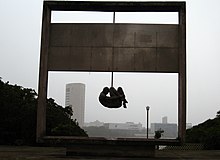
In Brazil, the use of torture – either as a means of obtaining evidence through confession or as a form of punishment for prisoners – dates back to colonial times.[3] A legacy of the Inquisition, torture never ceased to be applied in Brazil during the 322 years of the colonial period, nor later, during the 67 years of the Empire and the republican period.[4]
During the so-called years of lead, as well as during the Vargas dictatorship (the period called Estado Novo), there was the systematic practice of torture against political prisoners – those considered subversive and who allegedly threatened national security.[5]
- ^ "Repressão Política". Marxists.org (in Brazilian Portuguese). Retrieved 2014-06-20.
- ^ "Roteiro – Passeio Ciclístico Recife lugar de memória" (PDF). Prefeitura do Recife. Retrieved 2014-06-20.
- ^ ABI
- ^ Comissão de Direitos Humanos da Câmara dos Deputados (Brasil).A Tortura no Brasil – Um estudo sobre a prática da tortura por agentes públicos, a ação da Justiça, alguns casos emblemáticos acompanhados pela CDH e propostas de ações superadoras. Subsídio ao trabalho do Relator da ONU para a Tortura, Nigel Rodley, em sua missão oficial ao Brasil. Brasília – DF, agosto de 2000].
- ^ Dossiê virtual Anistia e crimes de lesa humanidade. Videoteca Digital de documentos da Tortura no Brasil.
